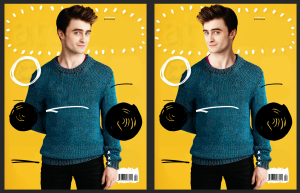INTRODUCTION
For my final DTP localization project, I chose to localize a cover magazine using Adobe Photoshop CC 2017 from English to Traditional Chinese. The course is designed to provide students with a solid foundation in multilingual desktop publishing concepts such as Adobe Suites, EPUB, Subtitling, Dubbing, as well as a deep understanding of typography and PDFs.
WORKFLOW
I know I wanted to use Photoshop for my Project Showcase from the very beginning but finding a suitable source material took a while. Finally, I settled on this magazine cover because it was challenging in the sense that it required some extremely detailed masking as well as multiple handwritten fonts.
I first made a Picture List of all the text that I needed to translate into Traditional Chinese.masked the easier sections of the cover, the ones with a solid background, using the Lasso Tool and Fill -> Content Aware tool.
Then, I masked the easier sections of the cover, the ones with a solid background, using the Lasso Tool and Fill -> Content Aware tool.

Then came the trickier part of the masking process. At first, I was impatient and selected “DANIEL RADCLIFFE” using the Wand Tool and used the Fill -> Content Aware tool again. The results were disastrous. As the saying “Patience is Virtue” goes, I undid the Fill step and painstakingly, selected tiny parts of the letters to Fill. Finally, when the texts in the middle were masked, the next step would be finding suitable fonts.
As there aren’t a lot of Chinese fonts, and even less for Traditional Chinese fonts, finding and trying out suitable fonts took me more than an hour to be satisfied. Surprisingly, my Macbook Pro already came with a few handwritten Chinese fonts, and in total, I used 11 different fonts with only three external fonts.

RESULTS
After that, it was just a simple copy and paste. I played with the leading and kerning of the Chinese characters to make them fit into the correct places. I was pretty satisfied with the end results.

PROBLEMS FACED/LESSONS LEARNED
At first, I was only using my trackpad on my laptop to select the texts to mask. However, my hand soon cramped up and it was hard to select the texts. So I took out my Wacom Intuos Tablet and the process became much faster and simpler. For delicate work like masking texts, I would suggest using a drawing tablet if you have the means to get one, it really helps!
As I mentioned, because there are so many existing Chinese characters, it is hard to find free handwritten fonts solely because it takes a long time for creators to create Chinese fonts. Also, since we do not bold the characters to emphasize certain words, I had to use “faux bold” for many fonts because most of the fonts do not have bold characteristics.
While localizing the magazine cover, I realized how delicate and detailed this process is and that patience really is the key here. Like I did in my first mistake, I wanted to rush the process by Filling the entire top part of the middle text, and it ended terribly. I now understand how important it is to start small.
BONUS
I also wanted to localize the magazine cover into one of the Right to Left languages, and I decided to go with Arabic since I studied it for three years. Since it’s a R to L language, I switched the arrow in the middle from pointing right to pointing left, and I even switched the direction DR’s face was facing.

I then switched my Language Options to Middle Eastern Features to allow the letter to appear from Right to Left and to connect. Then I started adding the text (using Google Translate) but couldn’t find as many fonts as I would’ve liked.
I encountered my first problem with the Title of the magazine. Since “Attitude” in Arabic is “‘uslub” and only consists of five letters, DR’s head would block off at least two of the letters, thus, making the word unreadable. After consulting with my Arabic professor, we decided it would be best to leave the title to one side of the cover instead of in the middle. He also said that this magazine would never make into the Arabic market anyways.

I ended up not finishing the R to L language since the Arabic language expand like Russian does and ran out of time to finish it. If I do come back to the project in the future, I would be sure to update the post with the finished product.


